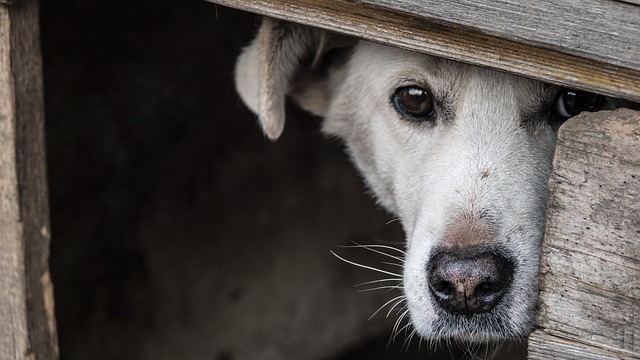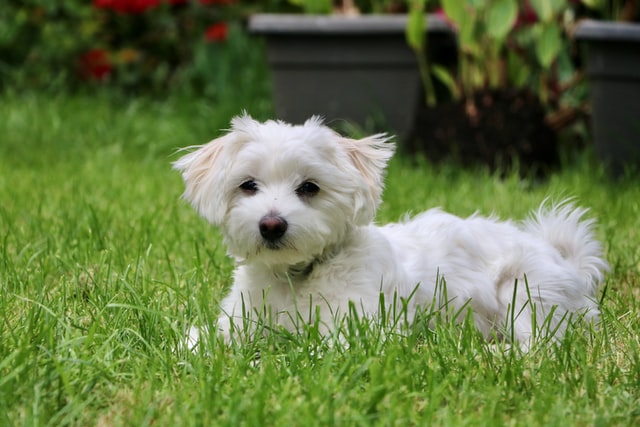How To Care For A Blind Dog And The Anxiety That Comes With It?
Caring for a blind dog is daunting but add the inevitable anxiety that your confused pooch will endure as well.
These pets are just as important and loved as ones that can see, so how can you help them through their daily struggles?
If your dog has become blind and you want to know how you can help them, then look no further!
This article will discuss some helpful tips and tricks to lowering their anxiety and making a happier and more comfortable environment.
Why Do Dogs Go Blind?
There can be a number of reasons for a dog to go blind.
The most common are cataracts, glaucoma, progressive retinal atrophy, old age, trauma and sudden acquired retinal degeneration (also known as SARDS).
It is also known that certain breeds as well as the gender can predispose a dog to blindness.
Sudden blindness or SARDS is more common in female dogs of middle age, especially if they are a Dachshund or Miniature Schnauzer.
Breeds such as the Miniature Poodle, Cocker Spaniel, Miniature Schnauzer, Golden Retriever, Boston Terrier and Husky are more prone to cataracts.
When adopting a purebred dog that is predisposed to a genetic eye condition, always ensure that the parents have been screened for those potential problems.
Another common reason for a dog to be blind is trauma to the eyes, whether that’s a scar on the cornea or they have had their eyes removed to spare them pain and infection from injury or hereditary condition.
How Do You Know If Your Dog Is Going Blind?
Besides a very obvious physical change to your dog’s eyes, it can sometimes be tricky knowing if their vision is starting to fail them.
It can be as minimal as a difficulty seeing in the dark or as severe as bumping into walls and furniture.
Cataracts are usually the easiest for owners to notice, being a large, white discoloration to the back of the dog's eyes, where progressive retinal atrophy (PRA) and SARDS are much less obvious.
Recognizing the symptoms of blindness can sometimes be slow to onset and owners may not notice right away. Here are some of the signs that your dog may be losing their vision:
- They are becoming clumsier or bumping into walls and furniture.
- They may have trouble locating their food, bed or other normal objects.
- Standing in strange places, or in one spot for prolonged periods of time.
Some less obvious signs of blindness are:
- The inability to see well in the dark (night blindness)
- Confusion in new environments
- Clinginess towards their owner
How To Care For A Blind Dog
A blind dog can still be a normal dog, but sometimes they need a little assistance.
It will also take some work and change from you and the other members of the household.
Here are the ways that you can help your blind dog cope with their new challenge.
- Establish a routine
- Have a route through the house
- Teach them verbal cues
- Speak when approaching
- Use bells and smells
Establishing A Routine And A Route With Your Blind Dog
Firstly, blind dogs need a routine as well as a consistent route through the common areas of the home.
This will help minimize the anxiety associated with navigating through unfamiliar areas, as well as reduce the risk of injury to their face or body from running into objects.
Do not move furniture around in your home often, as this can throw off your dog’s memory and route through the house, causing them anxiety as they have difficulty getting around.
Assess your home from your dog’s level and inspect furniture and other objects for potential hazards to your dog, especially items that are face and eye level with your pooch.
A routine helps your dog to get up and complete their normal tasks with you, so they know when they’ve been fed and when it’s time to go outside for potty and exercise.
An exercise routine is crucial for all dogs and people too.
Keeping the rest of your dog’s body in top shape is crucial for their overall health and happiness.
Blindness is no excuse for obesity in our four-legged friends!
Teaching Your Blind Dog Verbal Cues
Whoever said that you can’t teach an old dog new tricks was definitely wrong!
Dogs of any age can learn something new, especially when it’s important for their daily routine.
Verbal cues are an excellent way to help your blind dog adapt to their new situation.
Verbal cues such as “step”, “stop”, “say hello” and even directions can be a great way for your dog to understand what is going on around them.
“Step” is used to let your dog know that there is a step up or down, or maybe a different obstacle in front of them.
This way they are prepared for the change in ground so as to not trip to fall over something and cause injury.
“Stop” seems pretty obvious.
This helps them recognize that it is time to stop moving and sit, since they can no longer see that you have stopped.
“Say hello” is an important cue to alert your dog that a person is approaching.
This is especially great so that they know someone may touch them, keeping them aware of the potentially oncoming contact.
Speak To Your Blind Dog When Your Approach Them
Blind dogs can be easily started, and this is especially true if they suffer from hearing loss as well.
A dog that is blind but can still hear can at least be alerted that someone is approaching when you speak to them or walk with a heavy foot.
Any amount of noise or ground vibrations will easily alert your dog to your oncoming presence.
Using Bells And Smells For Your Blind Dog
Even if their eyes don’t work the same, you can always incorporate sounds and smells to get them more active or help them navigate around the home.
Bells are an important addition to a home with a blind dog as it can alert them to anyone that may be nearby or approaching them.
Consider putting bells on other pets in the home as well as wearing one yourself.
When it comes to play time, you can look into finding a ball with a beeping sound so they can still play fetch.
Smells are another way of getting your dog up and moving as well as keeping their brain more active.
Scents like vanilla and lavender are strong and easily picked up by your dog, making it something you can add to places your dog will often go to.
Hiding treats around the house (not difficult to reach areas) will keep them using their nose and other senses.
How To Know If Your Blind Dog Is Anxious
Blind dogs can often be anxious due to their condition, especially if they were not always visually impaired.
Often times, their anxiety manifests in ways such as:
- Pacing frequently
- Panting or drooling more than normal
- Barking
- Hiding
- Aggression
Sometimes these symptoms are noticed before or even after the diagnosis of blindness.
The best way to reduce their anxiety is to try and help your dog cope with their new daily life.
Here’s how you can help.
How To Help Your Blind Dog’s Anxiety
Anxiety in a visually impaired dog usually comes from confusion or lack of comfort with their surroundings.
The best method to reduce a blind dog’s anxiety is to help them feel more secure and comfortable with the situation at hand.
This is where establishing and routine, a route and verbal cues help the most.
It will be difficult to acclimate a visually impaired dog to the surroundings of a strange environment, so it is usually best to keep those dogs at home.
Now, if your blind dog has become comfortable with new environments, sounds and smells and you have them trained with verbal cues, then adventuring is certainly something that they can handle!
How To Care For A Blind Dog And Help Their Anxiety
Blindness is certainly something that many dogs can adjust to and live happy and fulfilling lives.
All it takes is helping them establish a routine, make a safe path through the house and teach them a few, but key, verbal cues for daily life and navigating new areas.
Your blind dog’s anxiety should ease as they grow more comfortable with their condition and their surroundings.
If you are at all concerned with your dog’s adjustment to being blind, don’t hesitate to contact your veterinarian.



![[Tested & +20 hrs] Anti Anxiety Music for Anxious Dogs](https://doghealthknowhow.com/wp-content/uploads/2021/11/Anti-Anxiety-Music-for-Anxious-Dogs-768x529.jpg)
![[20+ GIF] Hilarious Scared, Nervous, and Anxiety Dog Memes that Make You Laugh](https://doghealthknowhow.com/wp-content/uploads/2021/11/Scared-Nervous-and-Anxiety-Dog-Meme-768x529.jpg)
